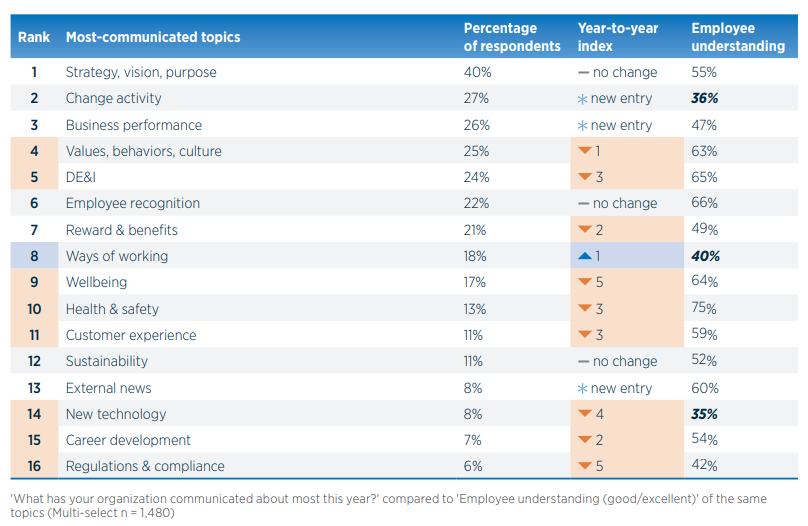
Gallagher’s State of the Sector Report for 2024 is a must-read for a comprehensive overview of the communications field but if you’re strapped for time, we’ve got you covered with the key takeaways for internal communications professionals. We’ll first highlight what’s stopping communicators from excelling, then share the most popular topics from 2023. Then we’ll dive into the following:
- Identifying what kind of communicator are you
- Measurement and impact
- How AI is shaking things up
- Communication channels and how effective they are
- Your next steps
Barriers of Success
When asked what would stand in their way of success in 2024, respondents ranked
- Lack of time/capacity in my team (35%)
- Disengaged employees (32%)
- Lack of budget/financial resources (25%)
- Internal technology/channels not fit for purpose (24%)
- Lack of analytics/measurement (19%)
Interestingly, none of these have changed year-to-year. Though, keep an eye out for challenges around engaging with non-wired/deskless employees and volume of communication. They’ve jumped up three and two places respectively.
Most Communicated Topics From 2023
Communications can be ineffective if everything is treated as equally important. Stakeholders often have different priorities and agendas, which can create confusion and overload for employees. Internal communication professionals have the challenging task of sorting out what is essential and relevant, and delivering it in a clear and engaging way. Here are some of the most communicated topics from 2023:
- Strategy, vision purpose
- Change activity
- Business performance
Despite the change activity ranking second and business performance ranking third, only 36% of respondents said employees had a good/excellent understanding for change and 47% for business performance. On the contrary, Health and Safety ranks in 10th place but is one of the best understood topics.

What else are communicators sharing with the organisation? (Source)
What Kind of Communicator Are You?
This year’s State of the Sector explores whether communications professionals are strategic, advisory, or supporting when it comes to deciding how to communicate, their contribution to content creation, and their influence where communications are shared. Here’s how to tell which one you are, what it means for your success and what you can do to grow.
Advisory communicators
Many internal communicators are still struggling to get a seat at the table. Perhaps due to the lack of understanding from senior leaders, internal comms professionals receive communications to push out after a decision is already made, indicating a lack of involvement in the decision-making process. Advisory communicators face the brunt of these challenges as they play a less strategic role in the organisation:
- Less influence in fostering organisational culture and understanding.
- Strong focus on content. Without the strategic element, they won’t be able to convey the value and importance of an internal communications role in the company
- Typically, in a small team. Exacerbating the top barriers to comms (lack of time, budget and resources)
- May face challenges in achieving success indicators and driving business impact.
Growing as an advisory communicator
Focus on these activities to enhance your communication approach and progress towards becoming a supporting or strategic communicator.
- Implement a measurement dashboard. This will support campaigns, improve understanding, and influence leadership
- Understand what employees need. Change activity is one of the most communicated topic this year. Addressing what your workforce needs to know about the changes not only improves employee understanding, but also aligns actions with business impact.
- Optimise communication channels. This will allow you to tailor content and get better at measuring your impact.
Supporting communicators
Supporting communicators describe internal communicators who provide advice and support to others rather than being strategic. If you’re a supporting communicator, you’re less likely to use measurement data to support communication campaigns, and you also tend to have less strategic involvement in HR and operational areas.
As a result, supporting communicators are less likely to drive business outcomes compared to strategic communicators, and have a lower impact on organisational culture. They also may experience lower wellbeing and job fulfilment.
Growing as a supporting communicator
- Collaborate with HR and exec teams. Engage with key stakeholders to get insight to organisational goals and align your communication initiatives with them for greater impact.
- Develop a comprehensive communication strategy. Create a master communication plan for the year ahead and reflect on progress for better outcomes.
- Focus on employee understanding. Prioritise improving employee comprehension of communicated topics.
Strategic communicators
If you’re a strategic communicator, you’ve hit the gold standard of success:
- See the big picture. They align actions with wider business objectives, and understand the impact of their communications on the wider business
- They connect the dots. Their actions link initiatives, departments, and targets – and they can amplify those connections
- Leverage measurement data. They use a mix of quantitative and qualitative data to support campaigns
- Focus on high-level topics such as strategy, vision, purpose; employee recognition; values, behaviours, and culture
Here’s what being a strategic communicator means for your success
- Better success in fostering organisational culture
- Employees are more likely to understand high-level topics better
- More likely to achieve business outcomes
- Leads to a stronger sense of purpose, fulfilment, and control — all of which contribute to a higher sense of wellbeing.
Measurement and Impact
Communicators are improving at measuring impact, with data collection increasing across all metrics, including reach, understanding, outcomes, and satisfaction.
- 84% of respondents want to measure more despite the number one barrier to measurement – the lack of time and resources
- There has been a more than 20% increase in respondents using measurement data to tailor content and build the business case for additional investment
- Giving feedback is easiest for mid-sized companies (1500-2499 employees)
- Strategic communicators focus more on outcome metrics like behaviour change rather than outputs like reach metrics
💡How to get better at measuring comms performance
- Measure what you can, and what’s relevant
- Be specific and intentional. Identify progress and improvement against prior performance
- The more specific and discrete with outlining intended behaviour and outcomes, the more straightforward measurement becomes
- Simplicity encourages regular, better informed data points that confidently impact decisions and wider initiatives
AI Usage and Perception
No surprises here! AI is a hot topic and communicators are starting to experiment with AI tools.
- 1 in 5 comms professionals are using AI to create comms
- In last year’s report, only 40% of respondents said AI would be impactful. Now, 68% believe AI will have an impact in the next five years.
- 60% of respondents indicate they are using AI, whether that’s experimenting with an AI tool or developing their own solutions.
- 3x more likely for communicators that are currently using AI to believe it will reduce workloads compared to the average
While AI will drive efficiencies and unlock innovative ways to communicate, the focus needs to be on getting the basics right. Here are some tips from the report:
- Want to be less afraid of AI? Experiment and seek out training opportunities.
- Implement feedback mechanisms to see how well AI experiments work
- Don’t be afraid to go back to a more manual process if it produces better results

Test out these prompts for your next communications message.
Employee Wellbeing and Satisfaction
Many communicators reported stagnating or deteriorating wellbeing over the past year, highlighting the importance of addressing employee needs and job satisfaction:
- Teams are shrinking – the average enterprise team size was reduced by 4.1 people since last year
- Smallest teams have the highest wellbeing score overall
- Concerning 38% reported that their wellbeing at work has deteriorated
- The passionate percentage were slightly better off than their peers, reporting a small uptick in wellbeing from last year. Yet they're at a higher risk of burnout. Communicators who actively demonstrate their value see expectations and workload increase, making it more of a challenge to deliver consistent quality.
- A significant proportion of communicators could see themselves happy in roles outside of communication, indicating potential risks for businesses if their needs are not met.
Channel Usage and Effectiveness
Getting the channel mix right enables communicators to reach and engage all employees (even deskless/non-wired staff) and ultimately makes the job easier.
- Face-to-face and web calls dominated in the effectiveness stakes
-
Are you taking advantage of effective channels? The most effective yet most underused broadcast channels are:
- Digital Signage: 72% effectiveness with 48% usage.
- Posters & Banners: 77% effectiveness with 44% usage.
- Employee Magazine: 87% effectiveness with 15% usage.
People Managers: Burden or Effective Channel?
As the proportion of deskless employees increases, we are seeing a greater reliance on people managers to share essential comms — but with managers less likely to meet expectations. With three in five respondents indicating that people managers are below expectations when it comes to communicating, does 2024 signal the start of a shift away from communicating through people managers? Here are three takeaways from the report on how to get the best out of people managers:
- Evaluate people managers on their ability to communicate
- Provide resources. Managers were 5% more likely to meet expectations when internal communication teams took responsibility for providing resources rather than HR or L&D — and 15% more likely when compared to those not receiving any resources. What’s more, if the resource provided by internal comms comes in the form of on-demand learning, we see a 35% increase in ability to meet expectations when compared to those managers receiving no resources at all.
- Provide managers with specific communications tools, such as how to have conversations about performance and pay, or talking points about organizational direction
Actionable Wrap Up
For those who are too skint on time to read the full report, here’s a list of next steps you need to take:
- Implement a measurement dashboard.
- Stay on track by demonstrating ROI with leaders.
- Articulate your EVP and be consistent in communicating it
- Collaborate with HR and exec teams to get ahead of the curve.
- Get clear on what employees need to understand about change.
- Provide managers with on-demand tools and resources.
- Create a master comms plan for the year. Don't forget these important dates.
- Refine your channel framework.
- Start experimenting with AI tools (safely and with purpose!). If you're looking for a starting point, here's out take on how to navigate AI safely.
- Run a communications audit, be sure to include focus groups and listening sessions.
- Take care of your own wellbeing!
- Check out last year's State of the Sector report (summarised of course)


